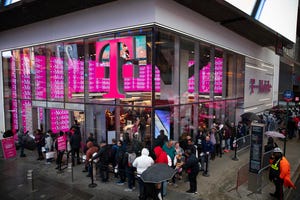Ericsson Boasts Small Cell Breakthrough
Swedish vendor unveils 'unique' Radio Dot System as its prime pitch for indoor cellular coverage. But how unique is it?
September 25, 2013

Ericsson has thrown down the gauntlet to its radio access network (RAN) infrastructure rivals with the unveiling of a new small cell product, the Radio Dot System, which, the vendor claims, deals with the main challenges faced by service providers that want their cellular service coverage to reach inside buildings.
Indoor cellular coverage is a major issue for mobile service providers, with about 70 percent of mobile traffic being generated indoors, according to Ericsson AB (Nasdaq: ERIC). In an attempt to address the indoor coverage issue, femtocells and picocells have been developed and deployed in homes and offices in recent years while DAS (distributed antenna systems) have also been deployed in larger buildings.
But neither of these options is very suitable for the mobile broadband age and the increasing volumes of data usage driven by smartphone and tablet users, according to Johan Wibergh, head of the Networks business at Ericsson. "DAS provides fairly good performance but is extremely costly, while femtocells and picocells still encounter performance challenges and require a great deal of improvement," says Wibergh.
Figure 2: Ericsson's Small Cell Handyman  Johan Wibergh, Ericsson's head of the Networks and chief advisor on home improvements, got busy with his drill at this year's Mobile World Congress in Barcelona.
Johan Wibergh, Ericsson's head of the Networks and chief advisor on home improvements, got busy with his drill at this year's Mobile World Congress in Barcelona.
Wibergh says operators have been asking for an indoor coverage solution that is cost-effective, delivers performance at the same level as with mobile macro cell coverage, and which is not physically obtrusive.
Ericsson believes the Radio Dot System delivers against these demands, though service providers will have to wait until the second quarter of 2014 to engage in trials, while full commercial availability is not expected until the second half of next year.
"We have been developing this for two years and recently had a breakthrough that led us to file for 14 patents," notes Wibergh, who says interference and distortion challenges have been addressed.
The Dot, which according to the vendor supports multiple cellular standards (including FDD LTE) and WiFi, is a small disc (10cm wide) that houses a very small antenna and runs the same software as the macro RAN products. It connects within buildings via standard local area network (LAN) cables (category 5/6/7) to a radio unit that then connects to a macro network base station.
Figure 1: Just Don't Confuse It With the Smoke Alarm  Ericsson believes its Radio Dot small cell is aesthetically pleasing as well as functional and cost-effective.
Ericsson believes its Radio Dot small cell is aesthetically pleasing as well as functional and cost-effective.
The news has certainly caught the attention of Heavy Reading senior analyst Gabriel Brown, who has been studying the small cell product market recently.
"It's an interest product and a departure for Ericsson in so far as it really attacks the deep in-building market," he says. "You can see the minimalist Scandinavian aesthetic at work in the Radio Dot design. This attention to detail indicates a well-thought-through system design and reflects the 14 patents Ericsson says were generated during the R&D work. Form follows function, you could say."
Brown adds: "The requirement for dedicated Cat 5 cable to each Radio Dot is a notable contrast to enterprise small cell solutions that operate over the switched LAN. It'll be interesting to see how this plays in the market. Ericsson is talking about cable runs of up to 200 meters so there's deployment flexibility, but it will typically require enterprises and operators to install new cable."
A unique offering
The vendor, naturally, believes its new offer is groundbreaking. "This completely redefines the market," claims Wibergh. "We believe the deployment costs are 70 percent lower than with DAS, so we believe this is something very significant as it makes indoor coverage and capacity economically feasible. The feedback we have is that this is something unique."
Unique? The team at SpiderCloud Wireless has developed an indoor coverage solution that uses a building's Ethernet cabling to power the small cells (or radio nodes) that feed traffic back to a centralized services node, which in turn connects to a mobile operator's packet core. (See Vodafone Deploys SpiderCloud's Small Cells and Look Out – Here Comes SpiderCloud!.)
"They are onto something similar," says Wibergh, but it's the ability to take the macro cell technology and replicate it in a pico form factor with a "new antenna design," and the ability to seamlessly coordinate and manage the macro and small cells that sets the Radio Dot System apart, notes the Ericsson man. "This is an affordable extension of the macro network into buildings. I don't think you'll find anything as unobtrusive as this anywhere else," he adds.
Huawei Technologies Co. Ltd. , which launched its Lamsite product in February this year, might also beg to differ, though, while Cisco Systems Inc. (Nasdaq: CSCO) might have something to say on the matter in the coming months. (See Huawei Unveils Innovative LampSite Solution for Deep Indoor Coverage at MWC and Cisco: Multimode Small Cells Coming Early 2014.)
— Ray Le Maistre, Editor-in-Chief, Light Reading
You May Also Like










